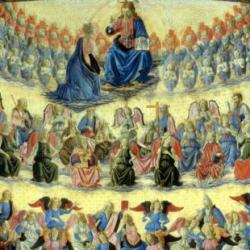Who were “the sons of God” in Gen 6.2 and v. 4? This expression occurs occasionally in the Bible, and it doesn’t always refer to the same type of beings. Sometimes, “the sons of God” refer to the mortal people of God (Mt 5.9; Rom 8.14; Gal 3.26). Twice, this expression refers to the future, resurrected, and thus immortal people of God (Lk 20.36; Rom 8.19). And “sons of God” can refer to angels (Job 1.6; 2.1; 38.7).
There have been three primary interpretations of “the sons of God” in Gen 6.2 and v. 4. Two of these interpretations identify them as men, and the other interpretation depicts them as angels.
First, a fragment of the Dead Sea Scrolls (4Q417) contains the earliest-known reference to the interpretation that “the sons of God” in Gen 6.1-4 are the “children of Seth,” and it condemns them for this rebellion against God. This interpretation says that these “sons of God” were Seth’s descendants who first began to “invoke the name of the lord“ (Gen 4.25-26), thus living for God, but they later rebelled against him by taking unbelieving, unrighteous daughters of Cain as their wives. Throughout church history, most Christians have believed this so-called “Sethite interpretation” of Gen 6.1-4. The main problem with this interpretation is that it does not provide an obvious reason why this sexual union resulted in descendants called Nephilim.
Second, many Jews and Christians have believed in the “fallen angels interpretation” of the sons of God in Gen 6.1-4. They say these sons of God were angels who had sexual relations with women that resulted in their offspring being giants. Many proponents of this interpretation claim that these Nephilim were both human and angelic.
This second interpretation of Gen 6.1-4 first appears in the Jewish, inter-testamental, non-canonical book of 1 Enoch in an elaborate and extensive scheme in chapters 6-12. Without citing Gen 6.1-4, it says 200 “angels” agreed by an “oath,” a “curse,” to commit “this great sin” (1 En 6.1-6). Proponents of this fallen angels interpretation often refer to this reference without also citing the outrageous assertions that follow, “And they took wives unto themselves,… And the women became pregnant and gave birth to great giants whose heights were three hundred cubits. These (giants) consumed the produce of all the people until the people detested feeding them. So the giants turned against (the people) in order to eat them” (1 En 7.1-4). Using the standard cubit, which is eighteen inches, this text says that these giants were 450 feet tall!
1 Enoch says Satan’s name is Azazel, which I don’t dispute. It also says Azazel and these angels “taught the people (the art of) making swords” and other weapons, jewelry, incantations, alchemy, and astrology “as well as the deception of man” (1 En 8.1-3). Furthermore, “Azazel … taught all (forms of) oppression upon the earth” (1 En 9.6). The angels “lay together with them—with those women—and defiled themselves, and revealed to them every (kind of) sin” (v. 8). That I dispute.
Proponents of this fallen angels interpretation no doubt rightly claim that these texts in 1 Enoch are an elaboration of Gen 6.1-12. 1 Enoch often calls these 200 angels “Watchers.” It tells about “the Watchers of heaven who have abandoned the high heaven, the holy eternal place, and have defiled themselves with women” (1 En 12.4). Proponents believe that this text means these angels defied God by leaving heaven to commit this evil of corrupting humans, and that is why they call it “the fallen angels interpretation,” meaning those angels spiritually fell.
Mainstream Judaism strenuously opposed this fallen angels interpretation of Gen 6.1-4. Ancient, rabbinical sources that render “sons of God” (Heb. beni-ha’elohim) in Gen 6.2 and v. 4, respectively, as “sons of the mighty/nobles/rulers/judges” are Targum Onkelos, Symmachus, Samaritan Targum, and Targum Neofiti. On the other hand, the jps, the most popular Hebrew Bible for Jews today, translates the critical expression beni-ha’elohim (“sons of the gods/God”) in Gen 6.2 and v. 4 as “divine beings.” Some modern scholars regard angels as “divine beings.”
(Early in my theological education, I was taught this “fallen angels interpretation” of Gen 6.1-4 by my pastor, a graduate of Dallas Theological Seminary. Years later, I listened to Theodore H. Epp give a series of messages on his popular “Back to the Bible” radio broadcast wherein he refuted this fallen angels interpretation. These messages were reproduced in a booklet I later obtained and read. I then became convinced, and remain so, that Mr. Epp was right.)
Third, the most compelling treatment of “the sons of God” in Gen 6, I think, is what is called “the royal interpretation.” It means that famous, ruling men—perhaps believing Sethites who declined spiritually—created harems (forcefully?) and thereby conducted human breeding. Concerning the word “took” (Heb. laqach) in Gen 6.2, B-D-B (p. 543) says it here means take “for oneself,” which may suggest the use of force. Regardless, over several generations their progeny resulted in giants. Some of these giant men no doubt accomplished amazing exploits that made them famous. These giant men probably were later deified in pagan legends, resulting in some of ancient mythology. Bruce Walke adopts this royal interpretation in his Genesis commentary (pp. 116-17). Although this interpretation avoids sexual intercourse between angels and women, perhaps Satan and his angels were the underlying cause of this wickedness.
Despite contrary evidence from the Dead Sea Scrolls, the “fallen angels interpretation” of Gen 6.1-4 may have been widely believed among Jews of the Second Temple period. Philo, in his book On the Giants (6), adopted it by paraphrasing Gen 6.2, “And when the angels of God saw the daughters of men that they were beautiful, they took unto themselves wives of all of them whom they chose.” The book of Jubilees, which scholars generally think was written prior to 100 bce, also adopts this angel interpretation of Gen 6.1-4 (Jub. 5.1; 7.21). It even says God’s angels are circumcised (Jub. 15.25-27), which, of course, requires that they have male genitalia. It also says “the angels of the LORD,” which in biblical phraseology would be God’s angels, took these women as wives. The Testaments of the Twelve Patriarchs (Test. Reuben, 5.5), written in about 150 bce, also endorses the angel interpretation of Gen 6.1-4. And the Genesis Apocryphon in the Dead Sea Scrolls has a narrative in which Lamech worries that his son Noah is not really his son but the progeny of the “Watchers” in Gen 6.2-4. (“Watchers” appears often in Jewish inter-testamental literature, and it refers to angels as in Dan 4.17, cf. vv. 13 and 23, from which it is no doubt derived.) 1 Enoch relates likewise, with Lamech saying of Noah, “he looks like the children of the angels of heaven to me; his form is different, and he is not like us…. It does not seem to me that he is of me, but of angels” (1 En 106.5-6).
In recent times, there has been a resurgence of scholarly support for the fallen angels interpretation of Gen 6.1-4. This can be seen in many modern commentaries on Genesis. For example, Gordon Wenham says of this text that the LXX and Latin Vulgate “understood the Nephilim to be the offspring of the ‘angel’ marriages, for in Greek mythology the gigantes were the product of the union of earth and heaven. And this is the way most modern commentators understand the term.”[1] (I think it is debatable that the LXX conveys that understanding.) Bible dictionaries are not any different. The popular, one-volume Harper’s Bible Dictionary (p. 696) says these Nephilim are “the offspring of daughters of men and divine beings (Gen. 6:1-4).”
Scholars who advocate the fallen angels interpretation of Gen 6.1-4 have been influenced by other non-canonical, apocalyptic, inter-testamental, Jewish literature that endorses this viewpoint, such as Jubilees 4.21-22; 5.1-11; 7.21-25. Furthermore, the increasing number of scholars who believe there are extraterrestrials in our universe often identify these Nephilim in Gen 6.1-4 as such. And some cite those assertions in 1 Enoch about the Watchers, whom these scholars deem extraterrestrials who taught humans various activities.
There are so many compelling objections to this fallen angels interpretation of Gen 6.1-4 that I think their overwhelming sum renders this erotic viewpoint as fallacious if not absurd!
First, Gen 6.2 says “the sons of God” took these women “as their wives.” This word “wives” necessarily presupposes some domestic life together, yet this interpretation only posits angels having sexual intercourse with these women.
Second, this interpretation requires a male chauvinistic view of angels, that all angels have male sexual organs that produce sperm compatible with human procreation. The Bible certainly never says this of angels. And it clearly presents angels as spiritual beings so that they cannot have physical sperm.
Third, while the Bible often describes angels appearing to humans as men, such texts likely only mean generically human.
Fourth, the Bible’s creation account, in which God tells his angels he will make human beings in his image, adds that he will make them “male and female” (Gen 1.26-27; 5.1-2). This suggests a contrast in which God and these angels are neither male nor female. And why would angels be only male in gender? The primary divine purpose for making humans, not to mention animals, male and female was for them to copulate and thereby reproduce their own species to populate the earth (Gen 1.27-28).
Fifth, this Genesis account only blames men for this evil, thus not angels. C.F. Keil (OT, 1:134) says of v. 3, “This sentence of God upon the ‘sons of God’ is also appropriate to men only.” For men, not women, sinned by taking women of whomever they chose. Presumably, they sometimes did it by force. Yet we afterwards read, “the wickedness of humankind was great in the earth, and that every inclination of the thoughts of their hearts was only evil continually” (Gen 6.5). Thus, God would destroy both men and women with the flood.
Sixth, why were the men regarded as wicked, yet all of humanity suffered the flood judgment, since men were not involved in the transgression of women copulating with angels?
Seventh, this interpretation is presented as though the women could not resist the angels impregnating them, which makes the women blameless.
Eighth, Sodom and Gomorrah were so rampant with homosexuality (Gen 13.13; 19.24) that Lot’s daughters wanted children and said “there is not a man on earth to come in to us after the manner of all the world” (Gen 19.31). This text not only restricts sexual intercourse to flesh, it seems to render angels as sexless beings.
Ninth, Jesus indicated angels do not have sexual organs, thus they cannot propagate, when he said of God’s people, “in the resurrection they neither marry nor are given in marriage, but are like angels in heaven” (Mt 22.30; cf. Mk 12.25; Lk 20.35-36). The reason for this should be obvious: resurrection bodies of God’s people will not be fleshly as they are in this life. This becomes apparent from some of the gospel accounts of Jesus’ post-resurrection appearances to his disciples, in which he appears and disappears instantly just as some biblical accounts present angels appearing to humans on earth and instantly disappearing. Many NT scholars claim that this saying of Jesus is the foremost biblical text that dispels the angel interpretation of Gen 6.1-4.
Tenth, it is impossible for angels and humans to have sexual relations that result in the birth of children because angels, like God, are sexless spirit beings who do not reproduce. For instance, Genesis relates, “God said, ‘Let us make humankind in our image’” (Gen 1.26). I think Jews rightly understand this means God spoke to a select group of angels. Then we read, “God created humankind in his image” (v. 27), adding, “male and female he created them,” suggesting that neither God nor angels are male or female.
Now, the NT has three mysterious texts that have rightly been connected to Gen 6.1-13. First, the Apostle Peter says in his first epistle that Jesus “was put to death in the flesh, but made alive in the spirit, in which also he went and made a proclamation to the spirits in prison, who in former times did not obey, when God waited patiently in the days of Noah” (1 Pt 3.18-20). Second, Peter similarly writes in his second epistle, “God did not spare the angels when they sinned, but cast them into hell and committed them to chains of deepest darkness to be kept until the judgment” (2 Pt 2.4). (The word “hell,” here, translates tartarosas, a place in the underworld Greeks called Tartarus.) Peter then connects this with Noah’s flood and mentions God’s destruction of Sodom and Gomorrah (vv. 5-8). Third, Jude writes of “angels who did not keep their own domain, but abandoned their proper abode, He [God] has kept in eternal bonds under darkness for the judgment of the great day” (Jude 6). Jude next mentions Sodom and Gomorrah as further examples of God’s judgment against immorality.
Although Genesis 6 only blames humans for the wickedness that caused God to destroy the earth by a flood, 1 Pt 3.18-20, 2 Pt 2.4, and Jude 6 fix the underlying cause of that sin on the influence of angels. It resulted in God casting them into the underworld’s Tartarus to await their final judgment. These verses are obscure to us because their authors are treating an important matter unknown to us that raises many questions. This suggests that these matters were not unknown to most first century Jews or else these two authors likely would have said more. If so, they may have used common oral, if not written, tradition that became non-extant. This is supported by (1) the last two passages fitting the same order of the destruction of the earth with a flood and the destruction of Sodom and Gomorrah, (2) angels deemed partly to blame for the evil, and (3) similar language or concepts are used. And these texts help interpret each other, such as “the spirits in prison” being “the angels…cast…into hell,” and these angels “did not obey” God in that they “did not keep their own domain, but abandoned their proper abode.”
[1] Gordon Wenham, Genesis 1-15 in WBC (Waco, TX: Word, 1987), 143.












